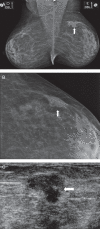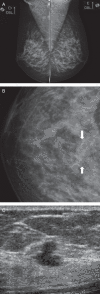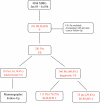Breast ultrasound diagnostic performance and outcomes for mass lesions using Breast Imaging Reporting and Data System category 0 mammogram
- PMID: 21552670
- PMCID: PMC3072469
- DOI: 10.1590/s1807-59322011000300014
Breast ultrasound diagnostic performance and outcomes for mass lesions using Breast Imaging Reporting and Data System category 0 mammogram
Abstract
Purpose: To evaluate the outcomes and diagnostic performance of ultrasonography after a Breast Imaging Reporting and Data System (Bi-RADS) category 0 mammogram.
Material and methods: This retrospective study reviewed 4,384 consecutive patients who underwent a screening mammography from January 2005 to July 2006; 391 of the 4,384 exams were classified as Bi-RADS category 0. After exclusions, 241 patients received subsequent sonogram. Ultrasonography was considered diagnostic when the Bi-RADS category was changed to 2, 4, or 5, and it was considered indeterminate (Bi-RADS 3) when the results indicated that the patients should return for a mammographic follow-up. The outcomes of these patients were assessed to evaluate the diagnostic performance of ultrasonography.
Results: The mean age of the patients was 53.3 years (ranging from 35 to 81). Of the 241 patients, ultrasonography was considered diagnostic in 146 (60.6%) patients and indeterminate in 95 (39.4%) patients. In the diagnostic group, 111 out of 146 patients (70.2%) had a sonogram result of Bi-RADS category 2 after a 2-year follow-up without evidence of malignancy. Furthermore, 35 out of 146 patients (29.8%) had a suspicious sonogram with a result of Bi-RADS category 4. After a tissue sampling procedure, 10 patients were confirmed to have breast cancer, and 25 had benign histopathological features without any evidence of malignancy after a 2-year follow-up. The sensitivity of ultrasonography was 100%, specificity was 89.1%, and overall accuracy was 89.6%.
Conclusions: Based on the degree of resolution and its diagnostic performance, ultrasonography was determined to be an excellent method for the subsequent evaluation of Bi-RADS 0 mammograms.
Figures



Similar articles
-
Growing BI-RADS category 3 lesions on follow-up breast ultrasound: malignancy rates and worrisome features.Br J Radiol. 2018 Jul;91(1087):20170787. doi: 10.1259/bjr.20170787. Epub 2018 Apr 25. Br J Radiol. 2018. PMID: 29658793 Free PMC article.
-
BI-RADS Category 5 Assessments at Diagnostic Breast Imaging:Outcomes Analysis Based on Lesion Descriptors.Acad Radiol. 2019 Aug;26(8):1048-1052. doi: 10.1016/j.acra.2018.07.018. Epub 2018 Sep 5. Acad Radiol. 2019. PMID: 30195413
-
Can artificial intelligence replace ultrasound as a complementary tool to mammogram for the diagnosis of the breast cancer?Br J Radiol. 2021 Dec;94(1128):20210820. doi: 10.1259/bjr.20210820. Epub 2021 Oct 18. Br J Radiol. 2021. PMID: 34613796 Free PMC article.
-
Understanding BI-RADS Category 3.Radiographics. 2025 Jan;45(1):e240169. doi: 10.1148/rg.240169. Radiographics. 2025. PMID: 39636752 Review.
-
Cystic Breast Lesions: Diagnostic Approach and US Assessment.Radiographics. 2025 May;45(5):e240179. doi: 10.1148/rg.240179. Radiographics. 2025. PMID: 40244873 Review.
Cited by
-
Breast cancer detection using sonography in women with mammographically dense breasts.BMC Med Imaging. 2014 Dec 30;14:41. doi: 10.1186/s12880-014-0041-0. BMC Med Imaging. 2014. PMID: 25547239 Free PMC article.
-
The value of noncontrast MRI in evaluating breast imaging reporting and data system category 0 lesions on digital mammograms.Quant Imaging Med Surg. 2022 Aug;12(8):4069-4080. doi: 10.21037/qims-21-968. Quant Imaging Med Surg. 2022. PMID: 35919041 Free PMC article.
-
Mammography in combination with breast ultrasonography versus mammography for breast cancer screening in women at average risk.Cochrane Database Syst Rev. 2013 Apr 30;2013(4):CD009632. doi: 10.1002/14651858.CD009632.pub2. Cochrane Database Syst Rev. 2013. Update in: Cochrane Database Syst Rev. 2023 Mar 31;3:CD009632. doi: 10.1002/14651858.CD009632.pub3. PMID: 23633376 Free PMC article. Updated.
-
Clinicopathological features of breast cancer without mammographic findings suggesting malignancy.Breast. 2020 Dec;54:335-342. doi: 10.1016/j.breast.2020.11.010. Epub 2020 Nov 26. Breast. 2020. PMID: 33285381 Free PMC article.
-
The impact of the COVID-19 pandemic on breast cancer screening and diagnosis in a Brazilian metropolitan area.J Med Screen. 2023 Mar;30(1):42-46. doi: 10.1177/09691413221122055. Epub 2022 Sep 7. J Med Screen. 2023. PMID: 36071628 Free PMC article.
References
-
- American College of Radiology (ACR) Breast Imaging Reporting and Data System (BI-RADS™), 4rd edition. American College of Radiology, Reston, Va. 2003
-
- Mainiero M, Goldkamp A, Lazarus E, Livingston L, Koelliker SL, Schepps B, et al. Characterization of breast masses with sonography. Can biopsy of some solid masses be deferred. J Ultrasound Med. 2005;24:161–7. - PubMed
-
- Stavros AT, Thickman D, Rapp CL, Dennis MA, Parker SH, Sisney GA. Solid breast nodules: use of sonography to distinguish between benign and malignant lesions. Radiology. 1995;196:123–34. - PubMed
-
- Rahbar G, Sie AC, Hansen GC, Prince JS, Melany ML, Reynolds HE, et al. Benign versus malignant solid breast masses: US differentiation. Radiology. 1999;213:889–94. - PubMed
-
- Berg WA, Blume JD, Cormack JB, Mendelson EB, Lehrer D, Böhm-Vélez M, et al. Combined screening with ultrasound and mammography vs. mammography alone in women at elevated risk of breast cancer. JAMA. 2008;299:2151–63. 10.1001/jama.299.18.2151 - DOI - PMC - PubMed
Publication types
MeSH terms
LinkOut - more resources
Full Text Sources
Medical

